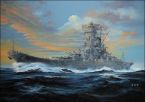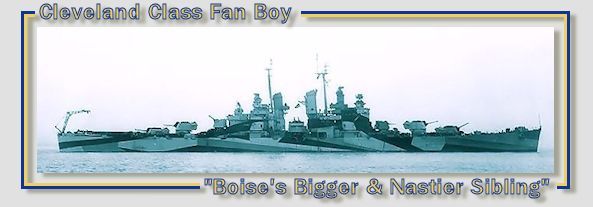castor troy
Posts: 14330
Joined: 8/23/2004
From: Austria
Status: offline

|
Superior British surface forces heavily damaged the IJN light cruiser Kiso which was later sunk by SS O24!
Background
Kiso was the fifth and last vessel completed in the Kuma-class of light cruisers. As with its sister ships, it was intended for use both as a long-range, high speed scout ship and also as a command vessel for destroyer or submarine flotillas.
Service Career
Early career
Kiso was completed on 4 May 1921 at Mitsubishi Heavy Industries Nagasaki shipyards. Soon after completion, Kiso was fitted with both a forward and an aft flat superstructure, with a rotating floatplane take-off platform located aft for experimental and testing purposes.
Kiso was then assigned to cover the landings of Japanese troops in Siberia during Japan's Siberian Intervention against the Bolshevik Red Army. It was subsequently based at Port Arthur, and patrolled the China coast between the Kwantung Leased Territory and Tsingtao.
On 17 April 1939, Kiso fired a 21-gun salute as the USS Astoria arrived at Yokohama carrying the remains of Hiroshi Saito, the Japanese ambassador to the United States, who died while on assignment to Washington DC.
Operations in northern waters
On 10 November 1941, Kiso was assigned to CruDiv 21 in the Japanese 5th fleet under Vice Admiral Boshiro Hosogaya, and was painted in Arctic camouflage for operations in northern waters. At the time of the attack on Pearl Harbor, the Kiso was patrolling in the Kuril islands, and after suffering hull damage due to severe weather, was forced to return to Yokosuka by the end of the year.
From January to end April 1942, Kiso resumed its patrol assignment in northern waters, accompanied by its sister ship, Tama.
In April, after the Doolittle Raid, Kiso was one of many vessels sent in unsuccessful pursuit of US Navy Task Force 16 with the USS Hornet, and USS Enterprise. Kiso's main batteries scuttled guard boats No. 26 Nanshin Maru and No. 1 Iwate Maru after those vessels had been damaged by planes from the Enterprise during the Doolitte Raid.
In May 1942, Kiso accompanied the converted seaplane tender Kimikawa Maru on a scouting mission to Kiska and Adak, in the Aleutian Islands. The Adak mission was successful, but Kiska was obscured by weather. At the end of (28 May 1942), Kiso was part of the Battle of the Aleutian Islands, in "Operation AL" (the seizure of Attu and Kiska). The invasion force landed troops on Kiska on 7 June 1942, with Kiso covering. On 10 June 1942, offshore Kiska, Kiso and several other ships and a few destroyers were attacked by a formation of six B-24 Liberator heavy bombers. Kiso was undamaged. Likewise, on 14 June 1942 Kiso was attacked by PBY Catalina flying boats, with near misses. Kiso returned safely to Mutsu Bay on 24 June 1942.
On 28 June 1942, Kiso and Tama participated in the second reinforcement convoy to Kiska, then patrolled southwest of Kiska in anticipation of an American counter-attack, returning to Yokosuka on 16 July 1942. From 16 July - 2 August 1942, after refit at Yokosuka, Kiso returned north to patrol around Kiska, and covered the transfer of the Attu garrison to Kiska on 20 August 1942, returning to Ominato on 18 September 1942. Kiso continued a series of patrol and resupply missions to the Kuriles and Aleutians from October through the end of March 1943.
On 28 March 1943, Vice Admiral Shiro Kawase assumed command of the Fifth Fleet. Kiso was sent to dry dock on 4 April 1943 for a major refit, during which its 900-mm searchlights were replaced by three Type 96 1100-mm searchlights. Two Type 96 twin-mount 25-mm AA guns were added at port and starboard above the aft torpedo-tube mounts. She was also fitted with a No. 21 air-search radar.
On 11 May 1943, Kiso was sent with the destroyers Hatsushimo and Wakaba to escort the Kimikawa Maru transporting eight Mitsubishi F1M2 ("Pete") Type 0 observation floatplanes and two Nakajima A6M2-N (gRufeh) fighter floatplanes of the No. 452 Kaigun Kokutai to Attu. However, the Americans invaded and retook Attu the same day, and the mission was scrubbed. Kiso was sent instead on 21 May 1943 to assist in the evacuation of Japanese forces from Kiska. After several attempts due to poor weather, Kiso managed to evacuate 1,189 troops from Kiska on 29 July 1943. It continued its patrols in the area until the end of August.
Operations in southern waters
On 15 September 1943, Kiso was assigned south, and ferried troops from Ponape, Caroline Islands to Truk, arriving 23 September 1943 and returning to Kure on 4 October 1943
Likewise, on 12 October 1943, Kiso and Tama embarked troops in Shanghai. The Kiso had a narrow escape from the USS Grayback (SS-208) while in the East China Sea, but safely arrived at Truk on 18 October 1943. From Truk, Kiso was assigned to carry the troops further, to Rabaul, New Britain. On 21 October 1943, 53 miles from Cape St. George, the cruisers were attacked by RAAF Bristol Beaufort bombers from Guadalcanal. Kiso sustained a direct hit by a 250-lb. bomb. The damage was severe enough to force a return to Maizuru for repairs. After arriving at Maizuru on 10 November 1943, Kiso was also modified by having its two 140-mm gun mounts removed and replaced by a dual 127-mm HA gun mount. Three triple mount and six single mount Type 96 25-mm AA guns were also installed bringing their total to 19 (3x3, 2x2, 6x1).
After modifications were completed on 3 March 1944, Kiso was sent north again to resume its patrol duties for the following three months. On 30 June 1944, Kiso and Tama were sent from Yokosuka with army reinforcements to Ogasawara islands, returning on 3 July 1944. Kiso was then kept in the Inland Sea area from 10 August 1944 for training and guard duties.
With the invasion of Leyte starting 20 October 1944, Kiso was ordered south, but was still at Kure taking on a resupply of ammunition for Vice Admiral Kurita's fleet at the time of the Battle off Samar on 25 October 1944. After departing Sasebo with carrier Junyo and DesDiv 30's Uzuki, Yuzuki and Akikaze, Kiso was spotted 160 miles west of Cape Bolinao, Luzon, Philippines by the USS Pintado. The USS Pintado was accompanied by the USS Jallao and the USS Atule and was working in close cooperation with the USS Haddock, USS Halibut and the USS Tuna. The USS Pintado fired all six of its bow torpedoes, but one of the Japanese destroyers came between the carrier and cruisers, sacrificing itself.
Admiral Kurita's ammunition was unloaded by 8 November 1944, whereupon the Kiso, together with the Junyo, cruisers Tone, Haguro and Ashigara, DesDiv 30's Uzuki and the Yuzuki following the battleships Yamato, Kongo and Nagato, light cruiser Yahagi with DesDiv 17's Hamakaze, Isokaze and the Yukikaze returned towards Japan. Kiso, Junyo, Tone and DesDiv 30 were detached to Manila instead. Kiso became the flagship of the Fifth Fleet, replacing Abukuma.
On 13 November 1944, on the threat of American carrier strikes on Luzon, Kiso was ordered to return to Brunei that evening carrying Vice Admiral Kiyohide Shima. Before she could leave for Brunei, she was attacked by more than 350 carrier planes of Task Force 38's carrier task groups 38.1's USS Hornet, USS Monterey and the USS Cowpens, TG 38.3's USS Essex, USS Ticonderoga and USS Langley and TG 38.4's USS Enterprise and the USS San Jacinto. Three bombs hit Kiso to starboard - one in the bow, one near her boiler rooms and one near her aft gun mounts. Kiso sank in shallow water eight miles west of Cavite at 1435N, 12050E. Captain Imamura and most of the Kiso's crew survived.
The Kiso was removed from the Navy list on 20 March 1945.
After the war, the wreck was salvaged on 15 December 1955, by the Nippon Salvage Company, which refloated the wreckage into Manila Harbor for breaking up.

 Attachment (1) Attachment (1)
_____________________________
|
 Printable Version
Printable Version










 Everything that is below 40 fighters on Cap will sooner or later see another attack of my bombers as I want to force him to keep at least two full Sentais of fighters there...
Everything that is below 40 fighters on Cap will sooner or later see another attack of my bombers as I want to force him to keep at least two full Sentais of fighters there... 




 and 11 CL!!!! It will be amazing how many DDs and cruisers will be left at the end of the next half year... if we keep up this speed, then the Japanese wonīt have more than two or three dozen DDs in mid 43!
and 11 CL!!!! It will be amazing how many DDs and cruisers will be left at the end of the next half year... if we keep up this speed, then the Japanese wonīt have more than two or three dozen DDs in mid 43!
 We lost 5:1 against Oscars and 4:0 against Zeroes, what do you think will happen when all those Army fighters will be Tojos? Japan only produces something about 300/month. A laughable number if you think about the fact that I get 35 of those P-38 wonder weapons...
We lost 5:1 against Oscars and 4:0 against Zeroes, what do you think will happen when all those Army fighters will be Tojos? Japan only produces something about 300/month. A laughable number if you think about the fact that I get 35 of those P-38 wonder weapons... 



 70 exp Lightnings lose 15:0 against Zeroes, 80 exp Warhawks lose 15:0 against Zeroes, will be some funny years...
70 exp Lightnings lose 15:0 against Zeroes, 80 exp Warhawks lose 15:0 against Zeroes, will be some funny years... 

 New Messages
New Messages No New Messages
No New Messages Hot Topic w/ New Messages
Hot Topic w/ New Messages Hot Topic w/o New Messages
Hot Topic w/o New Messages Locked w/ New Messages
Locked w/ New Messages Locked w/o New Messages
Locked w/o New Messages Post New Thread
Post New Thread